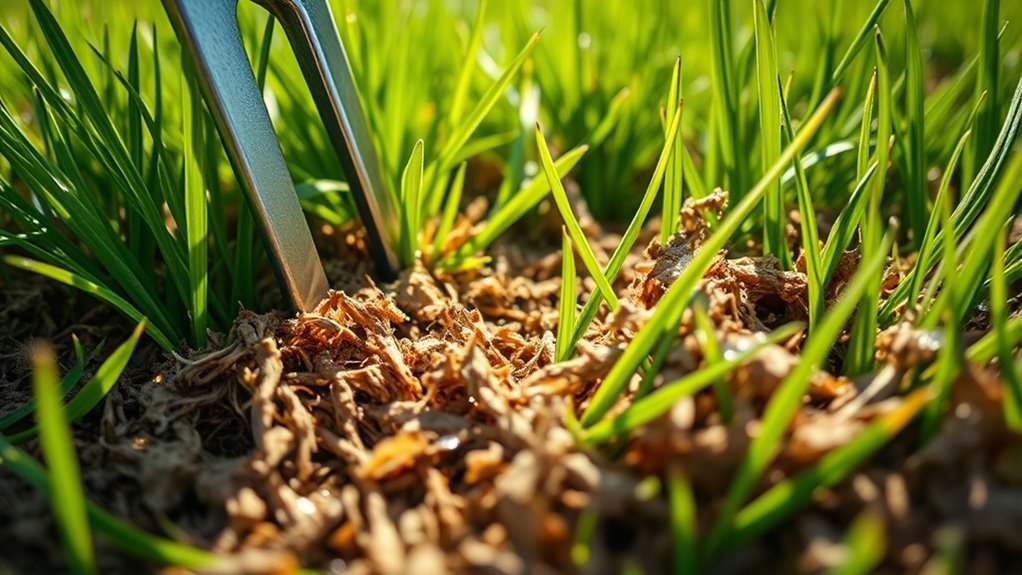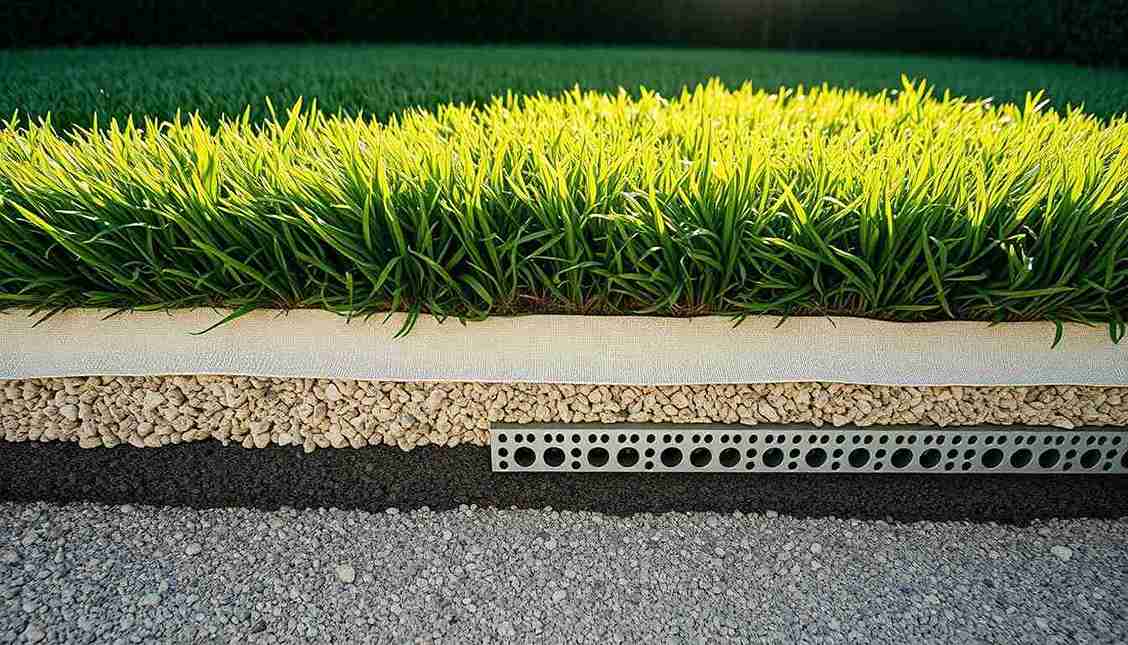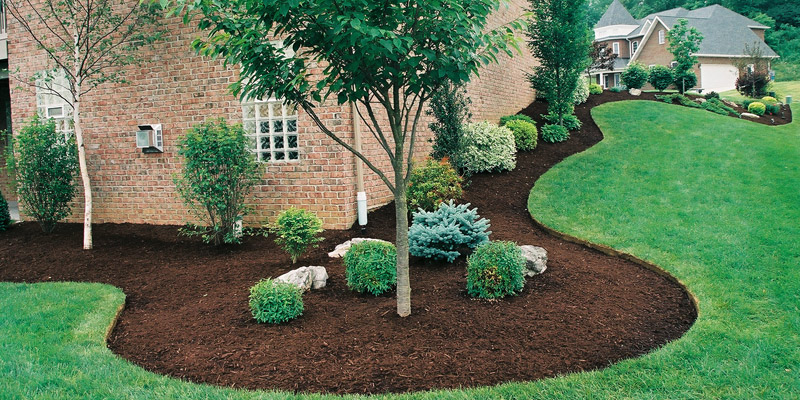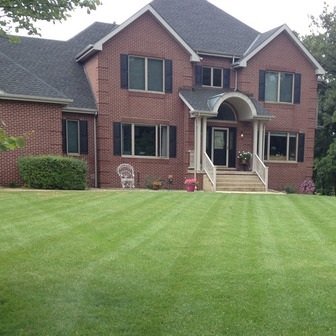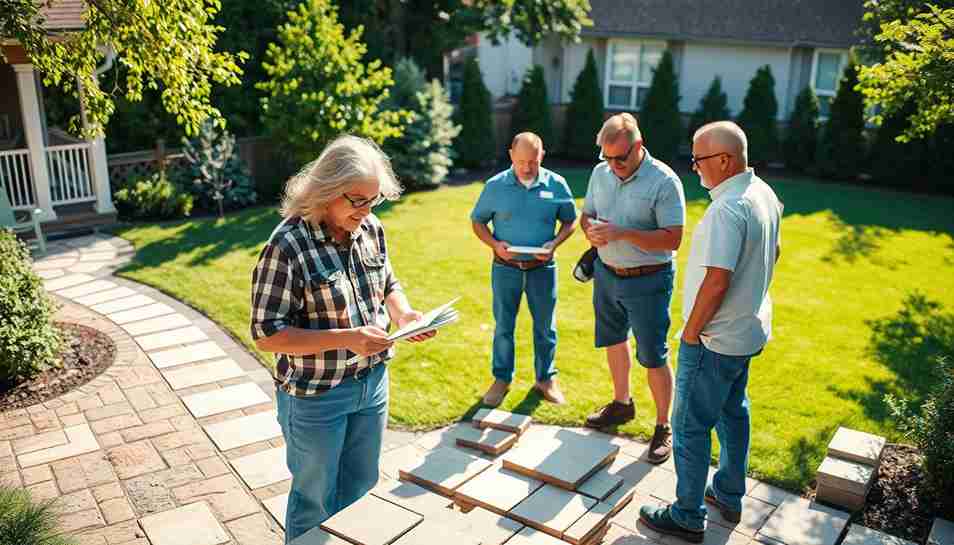Landscaping and lawn care serve fundamentally different purposes for your property. You’ll find landscaping involves thorough outdoor transformations, including hardscaping, plant selection, and design elements that can span months and require substantial investment. In contrast, lawn care focuses on routine maintenance tasks like mowing, fertilization, and pest control on a recurring schedule at lower costs. Understanding these key distinctions will help you make informed decisions about your outdoor space needs.
Understanding the Core Services
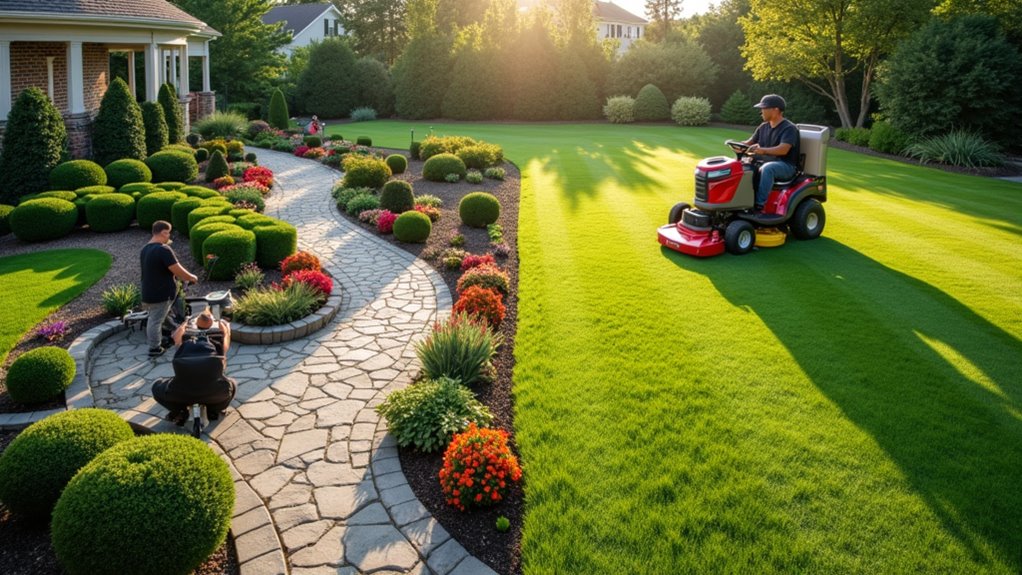
The distinction between scenery and lawn care services lies at the heart of outdoor property maintenance. When you’re evaluating these services, you’ll find that they serve fundamentally different purposes in property upkeep.
Landscaping encompasses extensive outdoor transformation, including hardscaping, plant selection, irrigation systems, and outdoor living spaces. You’ll need landscaping when you’re looking to redesign or overhaul your property’s exterior completely. In contrast, lawn care services focus specifically on lawn maintenance tasks like mowing, fertilization, and pest control. While landscaping projects can span months and require substantial investment, lawn maintenance operates on a recurring schedule at a more manageable cost. You’ll find that landscapers need expertise in complex areas like soil composition and ecosystem management, whereas lawn care professionals specialize in maintaining your grass’s health and appearance.
Professional Expertise Required
While homeowners can handle basic yard maintenance, professional landscaping and lawn care demand specialized knowledge across multiple disciplines. You’ll find that landscaping companies require staff with expertise spanning horticulture, design, engineering, and soil science.
| Discipline | Required Expertise |
|---|---|
| Horticulture | Plant selection, growth patterns, disease control |
| Design | Spatial planning, aesthetics, color theory |
| Engineering | Drainage systems, irrigation, hardscape construction |
| Soil Science | pH levels, nutrient management, composition analysis |
| Equipment | Operation of specialized machinery, maintenance protocols |
Professional expertise in these areas guarantees proper plant selection, effective drainage solutions, and sustainable landscape designs. When you hire experienced professionals, you’re accessing years of technical knowledge that goes far beyond simple mowing and trimming services.
Equipment and Tools
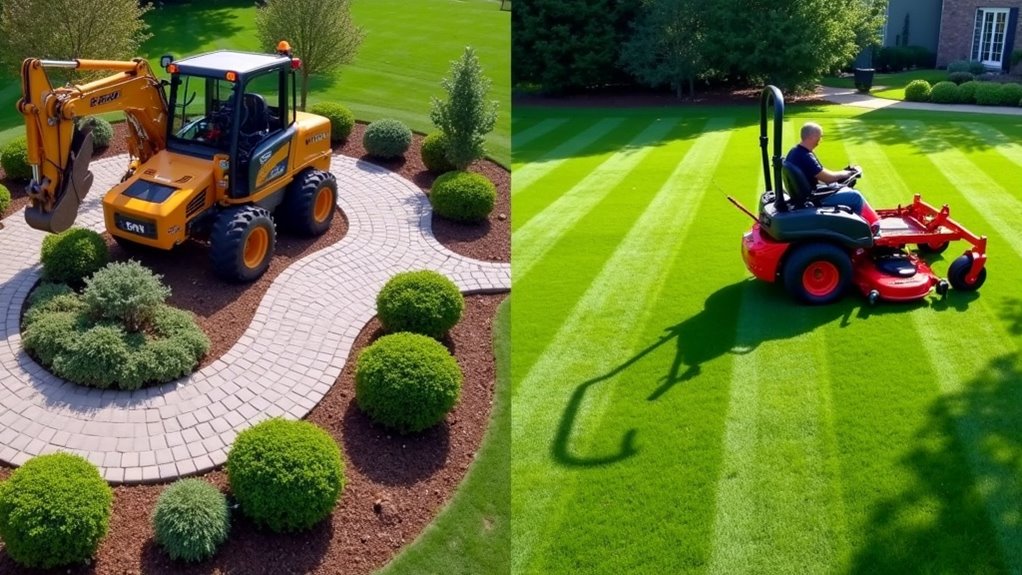
When you’re comparing professional landscaping and lawn care equipment to DIY tools, you’ll find that commercial-grade machinery like excavators and skid steers represents a significant investment that’s often impractical for homeowners. Your basic lawn maintenance requires simpler tools like mowers and trimmers, while installation projects demand specialized equipment such as sod cutters, augers, and hardscaping tools. The seasonal nature of landscaping work means you’ll need different tools throughout the year – from snow removal equipment in winter to aerators and dethatchers in spring.
Professional Grade Vs DIY
Major differences exist between professional-grade gardening equipment and DIY tools, creating a substantial gap in efficiency and capability. When you hire a lawn care company, you’ll benefit from their commercial-grade equipment, including GPS-guided mowers, professional aerators, and specialized trimmers that far outperform consumer models. These Services also utilize advanced soil analysis technology and maintain their equipment at peak performance through regular sharpening and maintenance.
You’ll notice that professional landscapers have exclusive access to commercial-strength fertilizers, herbicides, and pesticides that aren’t available at retail stores. While DIY lawn care relies on basic hand tools and residential mowers, requiring significant time and physical effort, professional crews utilize heavy-duty equipment that completes tasks more effectively and efficiently, delivering superior results in less time.
Maintenance Vs Installation Gear
The fundamental distinction between maintenance and installation equipment lies in their scale, complexity, and specialized applications. You’ll find that installation gear used in landscaping requires heavy-duty machinery like excavators and backhoes for major earthwork, while maintenance equipment focuses on routine lawn care tasks with lighter tools.
When you’re comparing the two categories, you’ll notice that installation equipment encompasses specialized hardscaping tools and powerful machinery for complex projects like retaining walls and water features. In contrast, maintenance gear typically includes walk-behind mowers, trimmers, and basic turf care tools. Your landscaping projects demand substantial power tools for tasks such as tree removal and land clearing, whereas maintenance equipment remains compact and portable, designed specifically for regular lawn upkeep and grooming activities.
Seasonal Tool Requirements
Successfully managing seasonal landscaping demands requires a strategic rotation of equipment throughout the year. You’ll need to adapt your tool selection based on specific seasonal requirements for both lawn care and landscaping projects.
- Spring demands a full arsenal of lawn care equipment, including mowers and spreaders for initial fertilizing, while landscaping tasks require excavators and augers for new installations and bed preparation.
- Summer focuses heavily on regular lawn care maintenance with frequent use of mowers and trimmers, while landscaping equipment supports hardscape installations.
- Fall calls for both lawn care tools like spreaders for overseeding and landscaping equipment for tree planting and grading projects.
- Winter primarily requires storage and maintenance of your equipment, though you’ll still need basic lawn care tools for occasional clean-up and landscaping gear for hardscape projects.
Time Investment and Project Duration
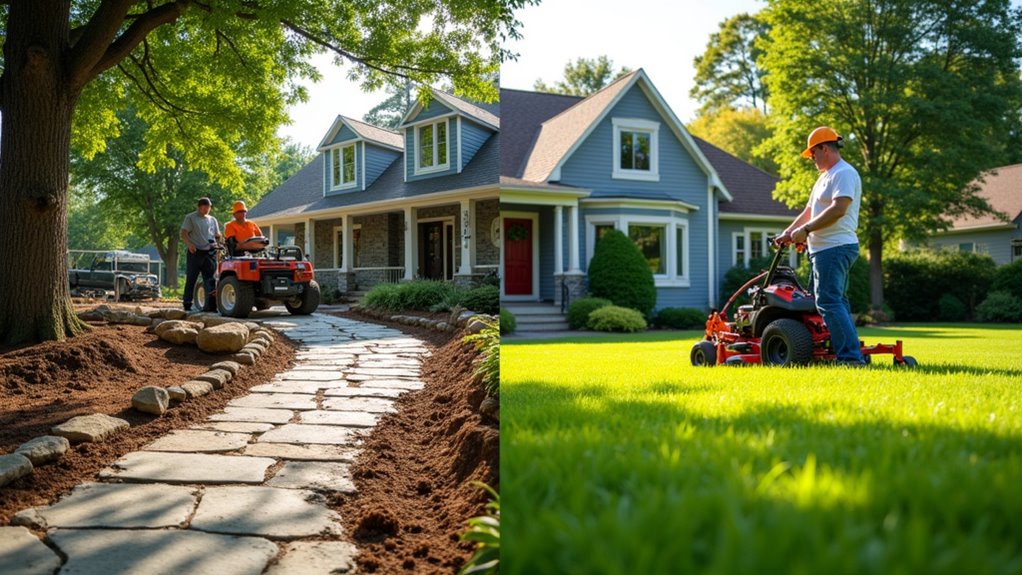
Understanding time requirements is crucial when choosing between landscaping and lawn care services. Landscaping is time-consuming and requires extensive upfront planning, design work, and installation, which can stretch from weeks to months depending on your project’s complexity. You’ll need to account for this significant time investment when planning major outdoor transformations.
In contrast, taking care of your lawn involves predictable, recurring maintenance that follows a consistent schedule. Lawn care tasks are more time-efficient, with routine services like mowing and edging typically completed in 15-20 minutes. You can expect regular visits from your lawn care provider to handle ongoing maintenance such as fertilization and basic upkeep. This systematic approach makes lawn care services more manageable and easier to schedule into your routine compared to extensive landscaping projects.
Cost Considerations and Value
While landscaping projects require significant upfront investments ranging from thousands to tens of thousands of dollars, lawn care services typically operate on more manageable monthly fees between $30-200. You’ll find that landscaping costs are driven by factors such as design complexity, material selections, and the need for specialized equipment and skilled labor. Your lawn care expenses, in contrast, will vary based on your property’s size, service frequency, and specific maintenance needs such as fertilization schedules or pest control requirements.
Investment Vs Monthly Expenses
Making informed decisions about property maintenance requires careful consideration of both immediate costs and long-term value. When comparing landscaping and lawn care services, you’ll need to weigh the financial implications of each option carefully.
- Initial investment in landscaping typically demands a larger upfront cost but delivers substantial property value improvement through permanent features and design elements
- Monthly lawn care expenses remain predictable and manageable, focusing on essential maintenance tasks that preserve your property’s baseline appearance
- Extensive landscaping projects can range considerably in price but often provide returns exceeding the initial investment through increased property value
- Regular lawn care services offer consistent pricing structures, making it easier to budget for ongoing maintenance without unexpected financial commitments
Your choice should reflect both your immediate budget constraints and long-term property value goals.
Price Factors Between Services
The price differential between landscaping and lawn care services stems from distinct operational requirements and service scopes. When you’re comparing costs, you’ll find that landscaping services demand higher investments due to specialized expertise, advanced equipment, and complex project execution involving hardscaping and outdoor feature construction.
You’ll notice that lawn care services follow more predictable pricing patterns, focusing on routine maintenance tasks like mowing and fertilizing. While you’re evaluating these services, consider that landscaping costs fluctuate based on project complexity, material selection, and design requirements. Your lawn care expenses, however, typically align with standardized industry rates for basic maintenance tasks. Understanding these price factors helps you make informed decisions: landscaping services offer transformative property improvements at premium rates, while lawn care provides essential maintenance at more modest, consistent price points.
Long-Term Benefits and Property Impact
Professional landscaping and lawn care services deliver substantial long-term value by augmenting both the aesthetic and financial aspects of your property. When you invest in these services, you’ll experience lasting benefits that extend beyond simple maintenance of your outdoor space.
- Your property value increases drastically through enhanced curb appeal and thoughtfully designed outdoor living areas that potential buyers find attractive
- You’ll benefit from sustainable landscaping features like drought-resistant plants and efficient irrigation systems that reduce water consumption and maintenance costs
- Regular lawn care protects your investment by preventing degradation of plant health and maintaining consistent aesthetic appeal
- Your mental well-being improves through carefully planned outdoor spaces that create private, peaceful environments while reducing noise pollution and environmental stressors
Frequently Asked Questions
What Is the Difference Between Landscaping and Lawn Service?
You’ll find that landscaping and lawn service are distinctly different in scope and complexity. While lawn service focuses on seasonal lawn maintenance requirements like mowing, fertilizing, and basic upkeep, landscaping involves thorough property transformation. Your landscaping project timelines typically span weeks or months, including design, hardscape installation, and plant selection. You’re investing in specialized expertise when choosing landscaping, whereas lawn service provides routine, recurring maintenance for your grass.
Do Landscapers Just Mow Lawns?
No, gardeners don’t just mow lawns. While they may offer basic lawn maintenance services, professional landscapers typically provide extensive outdoor design and transformation services. You’ll find they handle hardscaping (patios, walkways), planting design, irrigation systems, outdoor lighting, and scenery design planning. They’ll also manage soil health, drainage solutions, and structural elements. Some landscapers specialize exclusively in design and installation without offering any mowing services.
Does Landscape Include a Lawn?
Yes, your terrain typically includes a lawn as one of many components. When you’re planning your outdoor space, you’ll find that lawns integrate with other landscaping materials used, such as decorative stones, mulch, and hardscaping elements. While your lawn requires specific maintenance techniques like mowing and fertilizing, it’s just one part of your complete landscape design, which also encompasses trees, shrubs, flower beds, and architectural features that work together cohesively.
What Do Most Landscapers Charge per Hour?
You’ll find that gardeners’ average hourly rates typically range from $50 to $100 per hour for professional services. The rate you’ll pay depends on your location, the complexity of work, and the gardener’s experience level. Typical service packages often start at $500 for basic projects and can exceed $5,000 for extensive landscaping work. Some contractors prefer to charge by the project rather than hourly to provide more accurate cost estimates.


